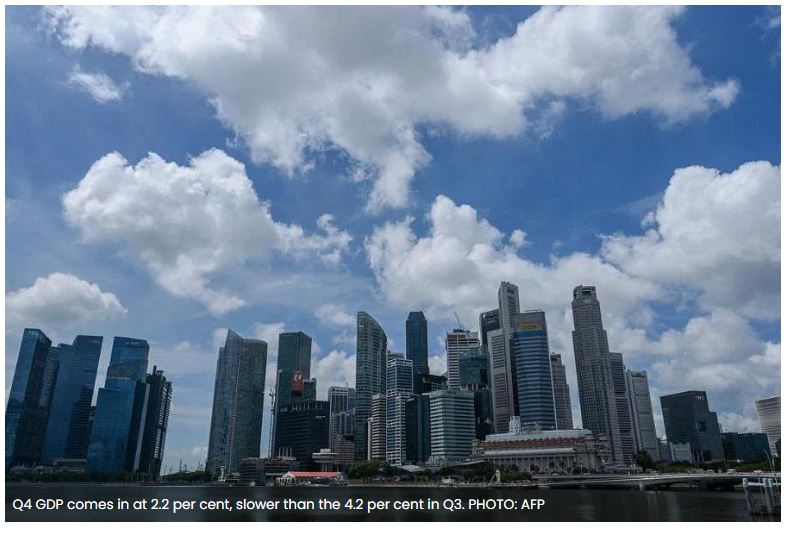Singapore GDP grows 3.8% in 2022, as Q4 moderates to 2.2%: flash estimates
SINGAPORE’S economy expanded 3.8 per cent year on year in 2022, with growth in the services sector helping to offset sluggish performance in the manufacturing sector, according to advance estimates from the Ministry of Trade and Industry (MTI) on Tuesday (Jan 3).
This makes last year’s gross domestic product (GDP) slightly better than the official forecast of “around 3.5 per cent” that MTI had narrowed to in November last year.
Fourth quarter GDP came in at 2.2 per cent year on year, slower than the revised 4.2 per cent seen in Q3.
Sequentially, the economy grew 0.2 per cent in Q4, improving from the previous quarter’s 1.1 per cent contraction.
The figures are largely in line with what private-sector economists had expected – a 2.1 per cent year-on-year expansion and 0.2 per cent quarter-on-quarter growth – according to a Bloomberg poll.
Still, the manufacturing sector shrank 3 per cent year on year in Q4, compared to a 1.4 per cent growth in the previous quarter. This is the sector’s first contraction since Q2 2020, when Singapore implemented a “circuit breaker” at the height of the Covid-19 pandemic.
For the full year, manufacturing grew 2.6 per cent year on year, a far cry from the 13.2 per cent growth it clocked in 2021 when it helped to support the economy before border restrictions and other Covid-19 measures were lifted last year.
“We expect more weakness ahead for the export-orientated manufacturing sector, with the external environment set to go from bad to worse,” said Alex Holmes, senior Asia economist at Oxford Economics. “Timely trade data show a sharp drop in exports and there is scope for further falls, with major export partners likely to slip into mild recession in early 2023.”
Construction grew 10.4 per cent year on year in Q4, improving from the previous quarter’s 7.8 per cent. This helped to bring full-year growth to 6.5 per cent, moderating from the 20.1 per cent expansion in 2021, when the sector rebounded from a deep contraction in the first year of the pandemic.
MTI noted that in absolute terms, the value-added of the construction sector remained 19.3 per cent below its pre-pandemic level in Q4 2019.
The services industries grew 4.1 per cent year on year in Q4, slowing from Q3’s 5.8 per cent. On the whole, the sector expanded 5 per cent year on year last year, slightly slower than the growth of 5.6 per cent in the previous year.
In his New Year’s Day Message on Dec 31, Prime Minister Lee Hsien Loong said the international outlook remains troubled.
“The Russia-Ukraine conflict continues, with no good outcome in sight. US-China tensions are likely to persist. How quickly China recovers from Covid-19 remains to be seen, while the US and EU may well enter recession. Our economy will be affected… we must brace ourselves for the uncertainties ahead,” he said.
MTI in November estimated the economy would grow by between 0.5 per cent and 2.5 per cent in 2023, a pace that it had said is “below trend”.
Economists are largely aligned with this view, with varying shades of pessimism.
Maybank economists Chua Hak Bin and Lee Ju Ye have kept their 2023 growth forecast at 1.5 per cent, citing mounting global headwinds that will “dominate over dissipating reopening tailwinds”.
Barclays regional economist Brian Tan is downgrading his growth forecast to 2.1 per cent, from 2.3 per cent, although he noted this is still in the “upper half” of MTI’s forecast range.
“While the slump in manufacturing and regional trade activity will likely be a drag this year, we believe the recovery in international travel and tourism still has legs, especially at the pace that China is relaxing its pandemic restrictions, including border controls,” he said.
OCBC chief economist Selena Ling is maintaining her full-year outlook at 2 per cent, with immediate growth and recession downside risks for the major economies partially offset by China’s earlier-than-expected pivot away from its zero-Covid policy.
RHB senior economist Barnabas Gan has kept his forecast at 3 per cent, with “sustained recovery” in Singapore’s services sector being the “bright side”, due to further recovery in air travel and tourism-related sectors.
“On this note, we think that the gradual reopening of China’s borders will be a boon to Singapore’s services sector, given that China was Singapore’s largest source of inbound tourism during the pre-pandemic period of 2017 to 2019,” he said.
While his research suggests a “slowdown to trend” but not recession in Q1, Gan said the balance of risks is “tilted towards a technical recession in 2023” even if that is not his base case.
Source: https://www.businesstimes.com.sg/singapore/singapore-gdp-grows-38-2022-q4-moderates-22-flash-estimates


 English
English




